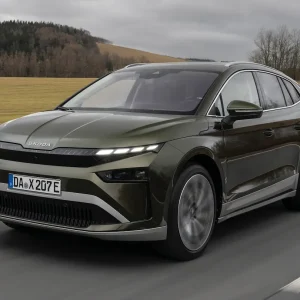Hyundai’s last Kona Electric attracted fleet attention thanks to its distinctive looks, high specification, and long electric range. So, it’s good to hear that for the second-generation Kona, it was designed from the outset as an EV – rather than being a converted ICE car. While other petrol and hybrid versions of the latest Kona are available, it’s the EV version, which we have here, that’s going to garner the most fleet attention, thanks to its 2% BIK figure.
Outside, like sister brand Kia, it seems that post-pandemic, Hyundai has found its own design mojo. However, unlike the Ioniq 5’s retro styling, and the Ioniq 6’s ‘streamliner’ fastback look, the Kona Electric looks like it has been on a bodybuilding course. It has chunkier detailing, especially around the arches, mixing futuristic design touches with the front and rear light bars. The Kona Electric has grown, too. Along with its 60mm longer wheelbase, it’s 25mm wider, 20mm taller, and 145mm longer than the last one.
Inside, the design follows Hyundai’s Ioniq models, with a pair of 12.3in screens sat on the top of the horizontally- styled dashboard, mounted side by side. Still, the infotainment is easy to use. Elsewhere, there are light metal details and lots of grey plastic. The grey plastic is probably the biggest interior letdown – because there’s so much of it, it’s easy to dismiss it as poor quality, which it isn’t.
The driving position feels tall, comfortable, and SUV-like, although on top of the retro-styled multi-function steering wheel being uncomfortable to hold, in our opinion it doesn’t have enough reach adjustment for taller drivers. Rear seat passengers will also be happy, with plenty of head and legroom. Plus, there’s plenty of useful stowage, and a practically shaped 466-litre boot, with an adjustable boot floor.
Ultimate is the range-topper, with plenty of premium kit, including heated and ventilated front seats, eco suede and leather trim, and an electric glass sunroof. Advance and N-Line grades are probably better suited to fleet.
The Kona Electric is available in two powertrain options, a 48.4kWh battery with 156hp, or the 65.4kWh battery and 218hp that we had in this test car. This can equal a claimed 319-mile range, although our car had 19in wheels equalling a lesser 282-mile range.
On the road, the Kona Electric feels quick off the mark and to the national speed limit – it’s refined, too. Despite the largest 19in wheels, the ride was impressively comfortable, however this seems to be at the expense of any driving dynamics. There is some response from the steering, but in the corners, you can feel this Hyundai’s substantial weight, and there’s plenty of body roll. Elsewhere, this Hyundai’s impressive assistance systems, like a lot of modern cars, seem to hinder more than help – the speed warning is particularly annoying. This Kona is best on the motorway, where its performance and comfort mix is the most attractive.
At just over £43,000, there are cheaper EV alternatives to this Hyundai on the market, including options such as the BYD Atto 3, and the MG ZS. However, that extra cost is worth it in the long run as the Kona Electric has stronger residual values. The Hyundai is also a comfortable, refined drive, with a spacious and modern interior.
Hyundai Kona Electric Ultimate 65kWh + Lux Pack
P11D: £44,640
Residual value: 45%
Depreciation: £24,065
Fuel: £3,806
Service, maintenance and repair: £2,324
Cost per mile: 50.32p
Range: 282 miles
CO2 (BIK %): 0g/km (2%)
BIK 20/40% a month: £14/£29
Luggage capacity: 466 litres
Battery size/power: 65.4kWh/218hp





